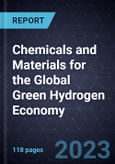Stakeholders will Advance Through Capacity Expansions, Production Scale-up, Technology Developments, and Strategic Partnering
This study analyzes the main chemicals and materials necessary in the green hydrogen value chain and assesses the roles of the various stakeholders in the green hydrogen economy. While it focuses on the companies that supply these chemicals and materials to the ecosystem, the role of component manufacturers and system providers in the development of the green hydrogen economy has also been examined.
Chemical companies are a crucial part of the green hydrogen economy and often strive to supply end-to-end solutions to the market. Several companies offer the chemicals and materials required to produce, store, distribute, and use green hydrogen. The study analyzes key factors in the green hydrogen value chain that these companies have to consider, such as regulations and their implications, supply-demand dynamics, and costs. The technology readiness of green hydrogen solutions and the rate of green hydrogen adoption across various applications have also been covered.
Storage and distribution are challenging aspects of green hydrogen owing to hydrogen’s inherent properties. The study examines the options available for safely and economically storing and distributing different volumes of hydrogen across different distances. The study concludes by identifying the growth opportunities emerging from this space for stakeholders and market players to leverage.
Table of Contents
Companies Mentioned (Partial List)
A selection of companies mentioned in this report includes, but is not limited to:
- Evonik
- Hexagon Purus
- Hydrogenious
- Plastic Omnium
- Toray








